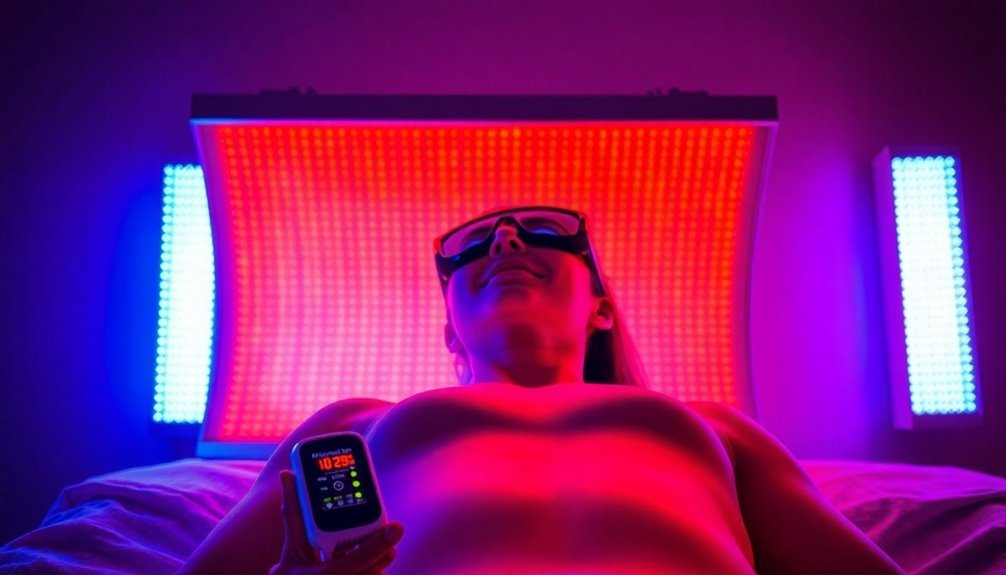You can boost your cellular energy production through seven powerful mitochondrial biohacks: Start with morning sunlight exposure to optimize your circadian rhythm, combine red light therapy sessions for enhanced ATP production, use strategic hot-cold exposure through saunas and cold plunges, stack mitochondrial supplements like CoQ10 and PQQ, incorporate HIIT and resistance training for increased mitochondrial density, prioritize 7-9 hours of quality sleep, and utilize advanced light therapy techniques pre and post-workout. Understanding these cutting-edge strategies will reveal your body's full energetic potential and transform your daily performance.
Optimizing Natural Light Exposure

Nature's most powerful mitochondrial booster is right outside your window. Sunlight directly enhances your cellular energy production by stimulating ATP synthesis and improving the efficiency of your electron transport chain through increased cytochrome c oxidase production. Your mitochondrial function peaks when you align with natural light cycles, particularly during morning exposure. Sunlight exposure also produces vitamin D sulfate in your skin, which provides unique benefits that supplements cannot replicate.
Start your day with 10-20 minutes of direct sunlight on your bare skin and eyes. This morning ritual triggers vitamin D synthesis, regulates your circadian rhythm, and strengthens your immune system through optimized mitochondrial function.
You'll also experience a boost in serotonin production, which helps regulate your mood and immune response while reducing inflammation.
To maximize these benefits, you'll need to balance exposure with protection. Build up your sun tolerance gradually by starting with morning light, which prepares your skin for beneficial midday exposure.
Remember to dim artificial lights in the evening and minimize blue light exposure to maintain your circadian rhythm. By following natural light cycles, you're not just supporting your mitochondria – you're enhancing your entire body's energy production system and immune function.
Red Light Therapy Fundamentals
Red light therapy's specific wavelengths (600-900 nm) directly target your mitochondria's cytochrome c oxidase, boosting ATP production and cellular energy levels.
You'll get the best results using red light (600-700 nm) for surface tissues and near-infrared (700-1200 nm) for deeper muscle and joint treatment.
For maximum mitochondrial benefits, you should aim for daily sessions of 10-20 minutes at 6-12 inches from the device, as longer exposure doesn't necessarily yield better results. These wavelengths help create new healthy mitochondria through stimulation of mitochondrial biogenesis.
Wavelength Effects On Mitochondria
Light's therapeutic power comes alive in specific wavelengths that directly influence your mitochondria's performance. The most effective wavelengths fall between 630-850nm for red light and extend to 940nm for near-infrared light, creating what scientists call the therapeutic window.
Regular exposure to these wavelengths can boost cellular activities and stimulate hundreds to thousands of mitochondria in each cell. You'll find that different wavelengths serve distinct purposes in your body. Red light at 670nm stimulates energy production within your mitochondria, while near-infrared light (760-1400nm) penetrates deeper to reach muscles, bones, and organs. The 850nm and 940nm wavelengths are particularly effective at boosting your electron transport system and improving cellular stress resistance.
When these wavelengths hit your cells, they trigger several beneficial responses. They'll increase your ATP production, enhance cellular respiration by reducing nitric oxide binding to cytochrome c oxidase, and boost your overall energy levels.
You're fundamentally giving your mitochondria an energy-producing upgrade that can lead to faster recovery and improved glucose metabolism. This scientific breakthrough, originally discovered during NASA's plant growth research, now offers you a powerful tool for optimizing your cellular energy production and maintaining mitochondrial health.
Optimal Treatment Duration Guidelines
Understanding ideal treatment duration can maximize your mitochondrial benefits from wavelength therapy. While there's no universally perfect exposure time, research consistently shows that even brief 3-minute sessions can effectively enhance mitochondrial function.
You'll want to prioritize consistency over length, as regular treatments yield better results than sporadic longer sessions. These sessions help stimulate ATP production through the electron transport chain in your mitochondria.
Clinical trials, like the REaLMS study using 670nm light, have demonstrated that 3-minute exposures can improve muscle function and mobility in patients with mitochondrial disease. If you're using red light therapy at home, you'll need to maintain a consistent schedule over several weeks to achieve lasting benefits.
Most studies indicate that a 4-week treatment period can lead to sustained improvements in energy levels and muscle performance.
When you're starting your red light therapy routine, stick to the manufacturer's recommended exposure times, which may vary based on your device. You can track your results through simple tests like grip strength or sit-to-stand exercises.
Remember that while longer sessions aren't necessarily better, maintaining regular short exposures will likely produce the most reliable energy-boosting effects for your mitochondrial health.
Heat and Cold Exposure

Throughout history, humans have harnessed the power of heat exposure to enhance bodily function, and modern science now confirms its remarkable effects on mitochondrial performance.
When you expose your body to mild heat stress (around 40°C), you trigger positive adaptations in your skeletal muscle that mirror the benefits of exercise. Research shows that two-hour daily sessions over six consecutive days can produce significant cellular adaptations.
You'll experience increased mitochondrial content and function through several key mechanisms. Heat exposure boosts heat shock proteins by up to 45% and activates important cellular pathways that promote mitochondrial biogenesis. Your muscle cells respond by increasing their respiratory capacity and enhancing their electron transport systems.
If you're unable to exercise, heat exposure can serve as a powerful therapeutic tool. It'll help preserve your muscle mass during periods of inactivity and improve insulin sensitivity if you have type II diabetes.
You can achieve these benefits through various methods, including passive heating or targeted deep tissue heating via pulsed shortwave diathermy.
However, you'll want to avoid extreme heat exposure, as it can impair mitochondrial function and trigger cell death. The key is maintaining moderate temperatures and consistent exposure patterns to optimize your mitochondrial adaptations while avoiding potential negative effects.
Strategic Supplement Stacking
While heat exposure can naturally enhance mitochondrial function, targeted supplementation offers another powerful approach to optimize your cellular powerhouses.
To maximize your mitochondrial performance, you'll want to combine specific supplements that work synergistically across three key areas: energy production, antioxidant support, and biogenesis.
Start with CoQ10 as your foundation, as it's essential for ATP production and acts as an antioxidant in mitochondrial membranes. Pair it with magnesium to enhance ATP synthesis and support enzyme activity.
Add Alpha-Lipoic Acid to boost carbohydrate breakdown and provide additional antioxidant protection. A daily dose of less than 2g carnitine can help transport fatty acids into mitochondria for optimal ATP production.
For thorough mitochondrial support, include Urolithin A (Mitopure) to promote the removal of damaged mitochondria and stimulate the creation of new ones.
You can further enhance your stack with PQQ and omega-3 fatty acids. PQQ triggers mitochondrial biogenesis, while omega-3s maintain membrane integrity and reduce oxidative stress.
For additional antioxidant protection, consider adding polyphenols like resveratrol or apigenin, which support both mitochondrial defense systems and biogenesis pathways.
Exercise For Mitochondrial Enhancement

Regular exercise stands as one of the most potent stimulators of mitochondrial health, with high-intensity training delivering the strongest benefits. If you're looking to optimize your mitochondrial function, high-intensity interval training (HIIT) should be your go-to strategy, as it triggers greater mitochondrial protein synthesis than moderate-intensity workouts.
You'll want to focus on exercises that activate PGC-1α, the master regulator of mitochondrial biogenesis. Even a single 45-minute cycling session at 75% of your VO2max can substantially boost mitochondrial protein synthesis. The most effective training programs typically aim to stimulate SIRT3 expression, which helps regulate mitochondrial oxidative capacity while reducing harmful reactive oxygen species.
When you perform high-intensity exercise, you're activating essential pathways involving AMPK, p38 MAPK, and CaMK, which all contribute to enhanced mitochondrial function.
However, don't overdo it – excessive exercise can actually impair mitochondrial function and glucose tolerance. Instead, maintain a consistent training schedule that challenges you without overwhelming your system.
This balanced approach will help you reap the benefits of exercise-induced mitochondrial adaptations, including improved endurance capacity, better metabolic health, and enhanced muscle performance as you age.
Sleep and Recovery Protocols
Quality sleep consistently emerges as a cornerstone of mitochondrial health, working in tandem with your body's circadian rhythms to regulate essential maintenance processes. During sleep, your mitochondria undergo vital repair and quality control mechanisms, including mitophagy and the clearance of harmful reactive oxygen species (ROS). The presence of melatonin as antioxidant helps protect your mitochondria by reducing oxidative stress during sleep periods.
| Sleep Impact | Mitochondrial Response | Recovery Strategy |
|---|---|---|
| Quality Sleep | Enhanced mitochondrial fusion/fission | Maintain consistent sleep schedule |
| Sleep Deprivation | Reduced respiratory function | Exercise to mitigate dysfunction |
| Circadian Disruption | Compromised ATP synthesis | Align activities with natural rhythms |
You'll want to prioritize sleep quality, as even five nights of restricted sleep can markedly decrease mitochondrial respiratory function and disturb your temperature regulation. When you experience poor sleep, your mitochondrial DNA release increases, triggering inflammation and oxidative stress that can impair cognitive function. To optimize your mitochondrial performance, establish consistent sleep patterns that align with your circadian rhythm. This supports proper mitochondrial proteostasis and maintains the delicate balance of fusion and fission events essential for cellular energy production.
Advanced Light Therapy Techniques

Building on the foundations of proper sleep, advanced light therapy represents a powerful tool for enhancing mitochondrial function. By strategically using red and near-infrared light, you'll stimulate your mitochondria's ability to generate ATP and enhance cellular energy production through improved oxidative phosphorylation. Modern research demonstrates that light therapy reduces creatine kinase levels, helping minimize muscle damage during intense training.
To maximize benefits, you'll want to time your light therapy sessions carefully. Apply red light therapy 3-6 hours before exercise to prime your muscle cells for peak performance.
In the morning, use light therapy to energize your cells and support your circadian rhythm.
For recovery, combine red and near-infrared light post-workout to reduce muscle soreness and inflammation.
The science behind these techniques is compelling: near-infrared light activates cytochrome c oxidase, a light-sensitive molecule that boosts oxygen consumption and ATP generation. This process not only enhances your existing mitochondria's function but also promotes the creation of new mitochondrial networks.
You'll experience improved muscle performance, reduced oxidative stress, and enhanced cellular respiration.
For the best results, incorporate light therapy into your daily routine, particularly during morning routines and pre-workout protocols.
Frequently Asked Questions
How Long Does It Take to See Noticeable Improvements in Mitochondrial Function?
You'll notice improvements in mitochondrial function within 2 weeks through high-intensity training. With consistent exercise and proper nutrition, you'll continue seeing enhanced energy production and muscle performance over the following months.
Can Mitochondrial Supplements Interact Negatively With Prescription Medications?
Yes, you'll need to be careful with supplements like CoQ10, which can interact with blood thinners and cancer drugs. Always consult your doctor before starting mitochondrial supplements alongside your prescription medications.
Are There Genetic Tests Available to Assess Individual Mitochondrial Health?
Yes, you can get several genetic tests to assess your mitochondrial health, including whole mitochondrial genome sequencing, panel testing, and specific tests for disorders like MELAS. Many labs now offer these specialized tests.
What Age Should Someone Start Focusing on Mitochondrial Optimization?
You should start focusing on mitochondrial health in your 20s or 30s, though it's never too late. Early intervention helps prevent age-related decline, and you'll see better results starting before dysfunction begins.
How Does Altitude Affect Mitochondrial Performance and Adaptation Strategies?
At high altitude, your mitochondria initially decrease in density but can adapt over time. You'll experience enhanced respiratory capacity through AMPK activation, though you'll need to manage increased oxidative stress during the adaptation process.
In Summary
You've now got the essential tools to supercharge your mitochondrial function and boost your daily energy levels. By combining strategic light exposure, temperature conditioning, targeted supplements, and proper exercise with recovery protocols, you're setting yourself up for peak cellular performance. Start implementing these biohacks gradually, and you'll notice improved energy, better focus, and enhanced overall well-being. Your mitochondria are waiting – it's time to power up.





Leave a Reply